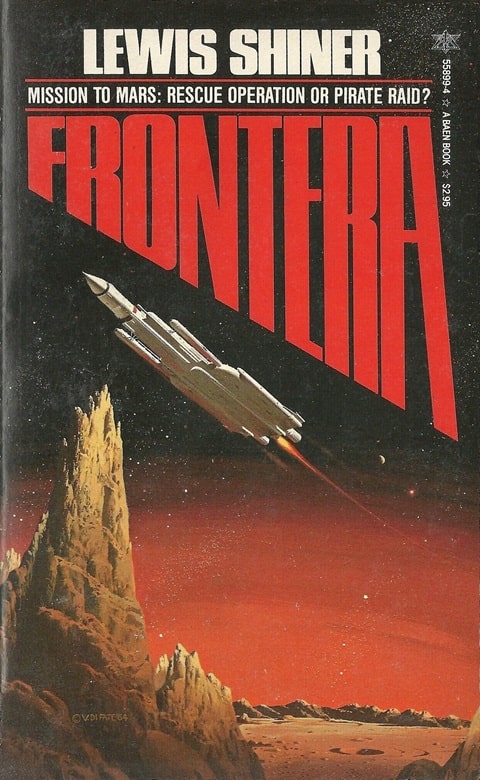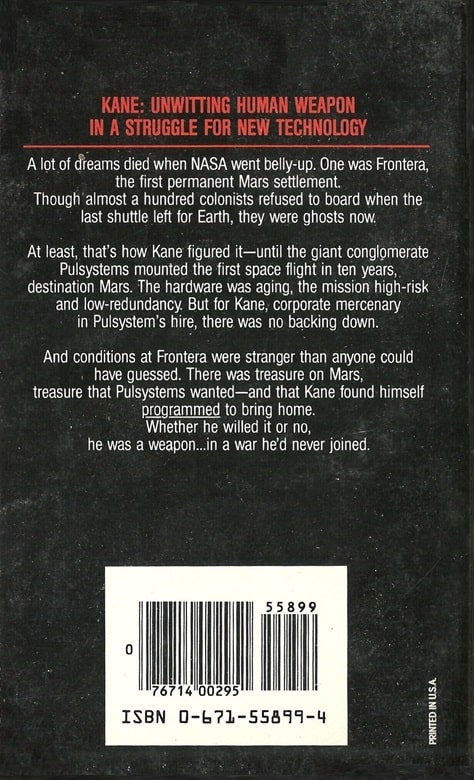Vintage Treasures: Frontera by Lewis Shiner
 |
 |
Frontera (Baen Books, August 1984). Cover by Vincent Di Fate
I first discovered Lewis Shiner in Gardner Dozois’ Year’s Best Science Fiction anthologies, where he was a regular, and one of my favorite contributors. His first published story, “Tinker’s Damn,” appeared in the fifth issue of Charles Ryan’s Galileo magazine in October 1977, and he followed that with dozens more all through the 80s and 90s in places likes The Magazine of Fantasy & Science Fiction, Twilight Zone Magazine, Omni, and especially Asimov’s Science Fiction.
His first novel Frontera, the tale of a high-risk expedition to a supposedly abandoned Martian colony, was published as a paperback original in what we used to call the Year of Big Brother, 1984 (that’s a George Orwell reference, for all you young folks). It was nominated for both the Philip K. Dick Award and the Nebula Award for Best Novel, and was followed by perhaps his most famous novel, Deserted Cities of the Heart (1988), which garnered another Nebula nom.
[Click the images to bring larger versions front and center.]
 |
 |
Collected Stories (Subterranean Press, November 2009), and Deserted Cities of the Heart
(Doubleday/Foundation, June 1988). Covers by Lewis Shiner and Bob Hickson
John Clute, at The Encyclopedia of Science Fiction, offers a concise and on-point summation of Shiner’s short fiction and first two novels.
His Collected Stories conveniently assembles more than half of his short work, which is various, tending at its best to a clear-edged intensity that gives his venues, whether or not sf, a glow of humane seriousness; at its less impressive, in earlier stories, there is a sense of overindustrious journeyman plundering of recent sf writers for models, Cyberpunk in particular. But increasingly an engaged and sophisticated mind could be seen extracting hard kernels of import out of those models, as can be seen in his several Shared World tales for the Wild Cards universe, beginning with “The Long, Dark Night of Fortunato” (in Wild Cards, 1987, edited by George R R Martin).
Shiner’s first novel, Frontera, in which a team is sent to Mars by a large corporation to investigate an abandoned colony, ostensibly obeys the sf-adventure rules governing tales of that sort, but insinuates throughout a bleaker, denser view of humanity’s life in space. Deserted Cities of the Heart, set in a Magic-Realist Mexico, features a complexity of plots, involving imagined Time Travel back to the age of the Mayas, heated sexual and political intertwinings, and moments of not entirely convinced Transcendence; but the style of the tale is shining and faceted, and its various protagonists are vividly realized as they hover closer and closer to a long-predicted Holocaust.
For many years Lewis Shiner was closely associated with cyberpunk, so I was surprised to see his first novel had an old-school space adventure sheen, rather than a straight-up futuristic urban noir, like George Alec Effinger’s When Gravity Fails or William Gibson’s classic Neuromancer.
I wasn’t the only reader with that expectation; here’s an excerpt from the 2017 review by Jesse at Speculiction, who ultimately puts Frontera firmly in the cyberpunk camp.
A lot of cyberpunk’s focus related to street tech and life, cybernetic enhancements, and data hacking thanks to the success of William Gibson, it’s easy to forget that its aspirations were broader in aim. Lewis Shiner’s 1984 Frontera, on top of being a debut novel, is a prime example of cyberpunk that does not fit the classic mold in aesthetic terms, yet adheres to its political and human tenets wonderfully.
With the collapse of world government in the face of mega-corporations, society has drastically changed form, and many public programs have fallen by the wayside. One such program is the terraforming Mars mission — the colonists essentially left on their own by Earth, NASA now disbanded. But one of the mega-corps, Pulsystems, has caught wind of a new technology that has evolved on Mars, and sends a ship with a few choice personnel, including the strange Kane, to learn more — in secret, if possible. Arriving planetside, Kane begins spending time among the colonists, digging ever deeper into their strange fabric to learn if any new tech exists, even as his own mind, and what strange things implanted by Pulsystems, threatens to shoot off course…
While many readers would argue otherwise, Frontera is for certain a cyberpunk novel. It may not present the aesthetic patterns so familiar to the sub-genre, but its distrust of the future, the manner in which technology redirects humanity’s path in unexpected ways, and the individual shaped by their technological surrounds are core ideas. There are no netrunners or neon-noir streets, virtual reality goggles or hovercrafts (but there are mirrorshades), instead Shiner populates his story with a gritty space colony, a questionable head implant, and a lot of personalities… In the end, Frontera is a strong debut that looks to find humanity within non-standard technological, domestic, and corporeal environments.
I’ve been looking for a classic 80s SF novel to help me unwind this weekend; Deserted Cities of the Heart was the first one I picked up, but I think I’ll be spending time with Frontera instead.
Frontera was published by Baen Books in August, 1984. It is 287 pages, priced at $2.95 in paperback. The cover is by Vincent Di Fate. Subterranean Press released a digital edition in 2011.
See all our recent Vintage Treasures here.
this one sounds great, and it is on audible, i think when i finish the new conan double feature (i had never read John Hocking’s first one, so i am glad they included it) i might start this though it looks like they have a collection of his short stories too. thanks for pointing out an author i have somehow never read.
Hi Dante,
I’m glad you mentioned John C. Hocking’s new book, Conan: City of the Dead. It’s the new release I’m most excited for this month. Black Gate readers will remember his excellent stories from the days of the print magazine, and I’ve been anticipating his long-lost Conan novel for years. It’s thrilling to have it in print at last!
yes! i also love Mr. Hocking’s stories that features in tales from the magicians skull, so i knew when this came out tuesday it would have to be a straight to the top of the TBR.